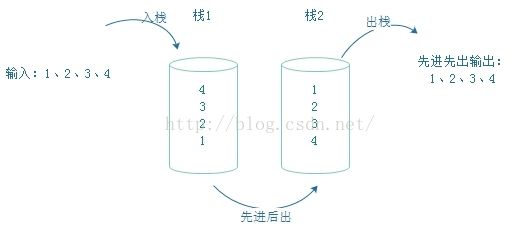两个栈实现一个队列的C++代码实现(7)
问题:用两个栈实现一个队列,完成在队列尾部插入节点和在队列头部删除结点的功能。
由于栈的特点是先进后出,要想实现队列,必须做到先进先出;
首先将数据输入到stack1中,这时候先进后出,再将stack1中的数据移动到stack2中,相当于将输入的数据的顺序颠倒,这样也就实现了队列的特点,先进先出。下面具体说一下队列为NULL,入队和出队的具体实现方法;
(1)判断队列是否为NULL:stack1==NULL && stack2==NULL,则队列为空;
(2)出队:如果stack1为NULL,stack2不为NULL,从stack2中直接出栈,也就是出队列;
如果stack1不为NULL,将stack1的数据出栈到stack2中,从stack2中直接出栈,也就是出队列;
(3)入队:如果stack2为NULL,直接入栈stack1,也即入队列;
改进之处: 出队时候:如果stack1不为NULL,此时需要将stack1中的元素移动到stack2中,其实不需要全部移完,如果移到stack1中只有一个元素的时候,就直接可以出栈,不需要将最后一个元素移动到stack2中,再在stack2中出栈;入栈也一样可以避免一次入栈和出栈,这对于频繁入栈出栈的程序可以大大提高它的效率。
实现一:利用容器。具体代码如下:
由于栈的特点是先进后出,要想实现队列,必须做到先进先出;
首先将数据输入到stack1中,这时候先进后出,再将stack1中的数据移动到stack2中,相当于将输入的数据的顺序颠倒,这样也就实现了队列的特点,先进先出。下面具体说一下队列为NULL,入队和出队的具体实现方法;
(1)判断队列是否为NULL:stack1==NULL && stack2==NULL,则队列为空;
(2)出队:如果stack1为NULL,stack2不为NULL,从stack2中直接出栈,也就是出队列;
如果stack1不为NULL,将stack1的数据出栈到stack2中,从stack2中直接出栈,也就是出队列;
(3)入队:如果stack2为NULL,直接入栈stack1,也即入队列;
如果stack2不为NULL,将stack2出栈到stack1中,数据入栈stack1,也即入队列;
示意图如下所示:
总之:我们规定stack1是入队栈,stack2是出队栈;反之也可以,这个比较随意。改进之处: 出队时候:如果stack1不为NULL,此时需要将stack1中的元素移动到stack2中,其实不需要全部移完,如果移到stack1中只有一个元素的时候,就直接可以出栈,不需要将最后一个元素移动到stack2中,再在stack2中出栈;入栈也一样可以避免一次入栈和出栈,这对于频繁入栈出栈的程序可以大大提高它的效率。
实现一:利用容器。具体代码如下:
#include<iostream>
#include <algorithm>
#include <stack>
#include <queue>
using namespace std;
stack<int> s1;
stack<int> s2;
void InQueue(int number)//入队
{
if(s2.empty())
{
s1.push(number);//stack1入栈,即入栈;
cout<<"InQueue:"<<number<<endl;
return;
}
while(!s2.empty())
{
s1.push(s2.top());
s2.pop();
}
s2.push(number);
cout<<"InQueue:"<<number<<endl;
/*这里为什么而是stack2入队?这主要是做了一个改进,其实和上面的步骤(1)(2)(3)不矛盾,因为stack1是入队栈,number进入stack1后可能马上就要出栈,所以又要将stack1中的数据移动到stack2中,所以避免了一个数据的入栈和出栈,提高了效率;*/
}
void OutQueue()
{
if(s1.empty())//s2出栈,即出队;
{
cout<<"OutQueue:"<<s2.top()<<endl;
s2.pop();
return;
}
while(s1.size()>1)
{
s2.push(s1.top());
s1.pop();
}
cout<<"OutQueue:"<<s1.top()<<endl;
s1.pop();
/*这里为什么而是stack1队队?这主要也是做了一个改进,同样和上面的步骤(1)(2)(3)不矛盾。因为stack2是出队栈,stack1中的number进入stack2后马上就要出栈,所以当stack1中只剩下一个元素的时候就是出栈的数据,就不必入栈stack2,同样也是避免了一个数据的入栈和出栈,提高了效率;*/
}
bool IsEmpty()//判断队列是否为NULL;
{
if(s1.empty() && s2.empty())
return 1;
else
return 0;
}
int main()
{
int array[]={1,2,3};
for(int i=0;i<3;i++)
{
InQueue(array[i]); //全部入队:1,2,3;
}
for(int i=0;i<3;i++)
{
if(IsEmpty()) //判断是否为NULL;
return NULL;
OutQueue(); //全部出队:1,2,3;
}
system("pause");
return 0;
}
运行结果:
方案二:链表实现栈:
#include<iostream>
using namespace std;
typedef struct My_Stack
{
int number;
My_Stack*next;
}stack1,stack2;
stack1 *pHead1=NULL;
stack2 *pHead2=NULL;
My_Stack *pEnd=NULL;
My_Stack *pNode=NULL;
void instack(My_Stack **phead,int data)
{
pNode=new My_Stack;
pNode->number=data;
pNode->next=NULL;
if(NULL==*phead)
{
*phead=pNode;
pEnd=pNode;
}
else
{
pNode->next=*phead;
*phead=pNode;
}
}
int outstack(My_Stack **phead)
{
My_Stack *temp=(*phead);
int number=0;
if(*phead)
{
(*phead)=(*phead)->next;
number=temp->number;
delete temp;
temp=NULL;
return number;
}
return NULL;
}
void InQueue(My_Stack **phead1,My_Stack **phead2,int data)//入队
{
if(NULL==(*phead2))
{
instack(phead1,data);//stack1入栈,即入栈;
cout<<"NN-InQueue:"<<data<<endl;
return;
}
while(*phead2)
{
instack(phead1,outstack(phead2));
}
instack(phead2,data);
cout<<"NN-InQueue:"<<data<<endl;
}
void OutQueue(My_Stack **phead1,My_Stack **phead2)
{
if(NULL==*phead1)//s2出栈,即出队;
{
cout<<"NN-OutQueue:"<<outstack(phead2)<<endl;
return;
}
while(*phead1)
{
instack(phead2,outstack(phead1));
}
cout<<"NN-OutQueue:"<<outstack(phead2)<<endl;
}
bool IsEmpty()//判断队列是否为NULL;
{
if( !pHead1 && !pHead2)
return 1;
else
return 0;
}
int main()
{
int array[]={1,2,3};
for(int i=0;i<3;i++)
{
InQueue(&pHead1,&pHead2,array[i]); //全部入队:1,2,3;
}
for(int i=0;i<3;i++)
{
if(IsEmpty()) //判断是否为NULL;
return NULL;
OutQueue(&pHead1,&pHead2); //全部出队:1,2,3;
}
system("pause");
return 0;
}运行结果:

